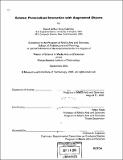| dc.contributor.advisor | Pattie Maes. | en_US |
| dc.contributor.author | Gatenby, David Arthur Gray | en_US |
| dc.contributor.other | Massachusetts Institute of Technology. Dept. of Architecture. Program In Media Arts and Sciences | en_US |
| dc.date.accessioned | 2006-08-25T18:54:54Z | |
| dc.date.available | 2006-08-25T18:54:54Z | |
| dc.date.copyright | 2005 | en_US |
| dc.date.issued | 2005 | en_US |
| dc.identifier.uri | http://hdl.handle.net/1721.1/33897 | |
| dc.description | Thesis (S.M.)--Massachusetts Institute of Technology, School of Architecture and Planning, Program in Media Arts and Sciences, 2005. | en_US |
| dc.description | Includes bibliographical references (p. 94-97). | en_US |
| dc.description.abstract | In Galatea, digitally augmented physical objects actively attract a person's attention to online information relevant to both the object and the person's interests. Galatea combines intelligent software agents and digitally augmented physical objects to uniquely bridge the gap between the two disciplines. In a unique twist on typical Ubiquitous Computing models that require intentional request for or asynchronous, periodic delivery of information, Galatea's smart objects proactively attract the attention of a nearby person by blinking a light when there is relevant information about the object. The object also sends the relevant information to the person's cell phone. We use books as our test case. Any augmented book can visually attract a user's attention when there is information it believes is relevant to the user. This information is personalized, i.e. unique to the person's interests, the current location, and the book, and when appropriate is delivered unobtrusively using the person's cell phone interface. A user can likewise request information from the books in the nearby vicinity by searching the books using their cell phone. A user study of and demonstration responses to Galatea show tradeoffs between the benefits of orienting information in objects and its usefulness as a collaborative tool, versus its potential as a distracting and invasive interface. | en_US |
| dc.description.statementofresponsibility | by David Arthur Gray Gatenby. | en_US |
| dc.format.extent | 102 p. | en_US |
| dc.format.extent | 5696850 bytes | |
| dc.format.extent | 5701121 bytes | |
| dc.format.mimetype | application/pdf | |
| dc.format.mimetype | application/pdf | |
| dc.language.iso | eng | en_US |
| dc.publisher | Massachusetts Institute of Technology | en_US |
| dc.rights | M.I.T. theses are protected by copyright. They may be viewed from this source for any purpose, but reproduction or distribution in any format is prohibited without written permission. See provided URL for inquiries about permission. | en_US |
| dc.rights.uri | http://dspace.mit.edu/handle/1721.1/7582 | |
| dc.subject | Architecture. Program In Media Arts and Sciences | en_US |
| dc.title | Galatea : personalized interaction with augmented objects | en_US |
| dc.title.alternative | Personalized interaction with augmented objects | en_US |
| dc.type | Thesis | en_US |
| dc.description.degree | S.M. | en_US |
| dc.contributor.department | Program in Media Arts and Sciences (Massachusetts Institute of Technology) | |
| dc.identifier.oclc | 66528426 | en_US |
